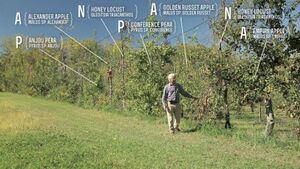Orchard
Jump to navigation
Jump to search


Stefan Sobkowiak demonstrating a trio in his permaculture orchard.
An orchard is a land planted with fruit trees. Traditional orchards are grown to maximize a yield of a specific fruit and grown as a monoculture susceptible to disease and pests and highly reliant upon chemical fertilizers and pesticides.
Permaculture Orchard
Stefan Sobkowiak, in the film The Permaculture Orchard, provides principles on creating a more ecologically responsible orchard.
- Choose a Site
- Select a site where you can dig a hole 4-6 feet without reaching the water table. Determine this by digging a hole to this depth using a post digger on a day without recent rainfall and collect soil from the bottom of the hole. Squeeze the soil in your hand and ensure no water is squeezed out.
- If you reach the water table before reaching the proper depth and determined to plant at that site, you can cut and fill your planed rows.
- Avoid planting at the top 50 feet of a slop to avoid strong winds, and near solid objects and the bottom 50 feet of the slop which are susceptible to frost pockets.
- Design the Orchard
- Use a NAP trio layout and group trees by similar harvest dates together in rows to aid in harvesting and cross-pollination.
- Grow berries and herbs, also grouped by harvest date, in the space under and between trees in the understory.
- Select a large variety of zone-appropriate diseases and pest-resistant cultivars. Sobkowiak recommends selecting first by taste, then resistance, and storagability.
- Install a misting irrigation system to protect flowers and fruit from frosts.
- Planting and Grafting Trees
- Select smaller and younger trees of the desired cultivar at a nursery for ease of planting. Larger trees may appear more impressive but cost more, are harder to plant, and most of the fine root-hairs will be damaged during transplanting as opposed to the smaller trees where all or almost all of the fine root-hairs are intact. Smaller transplanted trees will catch up to the larger transplanted trees in one to two years.
- Select rootstocks that perform well in your area.
- Plant trees at a spacing so the crown of mature trees touch but don't interlock. Space rows at least 12 feet apart if using heavy equipment during pruning or harvest.
- Select barerooted trees if available.
- Plant the tree.
- Consider overgrafting if existing, but undesirable, trees are already in place. This allows utilization of years of root growth in the previous tree instead of having to start anew.
- Mulch
- Run drip tape on top of the soil down the orchard rows. For sandy soil, where the water quickly drains, run three irrigation lines with one down the middle and the others about 18 inches on each side. For heavy clay soil, where the water tends to spread, one irrigation line down the middle should be sufficient.
- Maintain a thick layer of mulch down the orchard rows and over the irrigation lines, about six feet across. Mulch smothers competing plants that are competing for the same nutrients, helps retain moisture from the rain and irrigation, and encourages earthworms to gather near the tree.
- Position any understory plants close to the irrigation lines.
- Understory Plants
- Plant edible shrubs at in the tree rows to increase yield, with at least one positioned on the side of each tree facing the sun to prevent sunscald in the winter.
- Plant shrubs. Depending on tree spacing and objects, plant up to four shrubs in a square around each trunk, three to four feet apart. Plant additional shrubs between the trees at that spacing if there is room.
- Grow plants in the herbaceous layer that add to the yield, attract beneficial insects, and repel pests. Select species that require more sun in the microclimate in front of the trees that faces the sun, and plant species that require or tolerate shade in the microclimate behind the trees.
- As opportunists develop, remove and replace them with a desired plant to take advantage of the resources the opportunist was exploiting.
- Work with Allies
- Provide shelters various sized nest boxes for birds who feed on pests. Expect a maximum occupancy rate of 50 percent as many species of birds defend a primary and contingency nesting site.
- Provide bird seed and suet feeders to attract birds and move the feeders' positions to places with high levels of pests to allow the birds to find and feed on the pests.
- Start a beehive for honeybees in the orchard, and provide nesting for other pollinators such as bumblebees and mason bees.
- Maintenance
- When branches on the fruit trees are about one yard long, bend it towards the ground and secure its position with a bent wire with one end hooked around the branch and the other around the trunk. The wire needs to be in place for roughly two months to train the branch to permanently keep its new position. This stimulates growth hormones in the tree to focus it on bearing fruit instead of growing larger and greatly reduces the amount of pruning needed later.
- The branches of nitrogen-fixing trees can also be trained downward to encourage the tree to take up less space in the orchard.
Links
- The Permaculture Orchard - Official film website